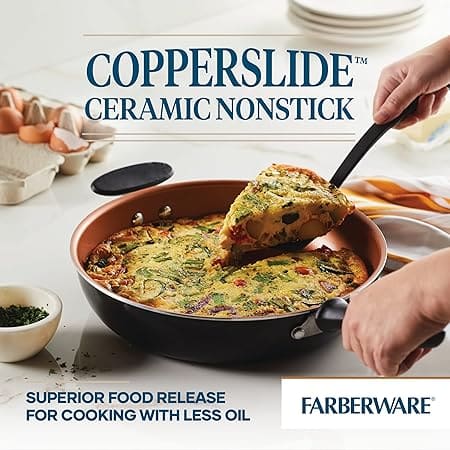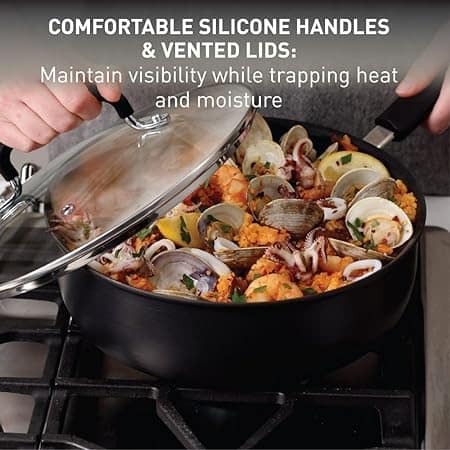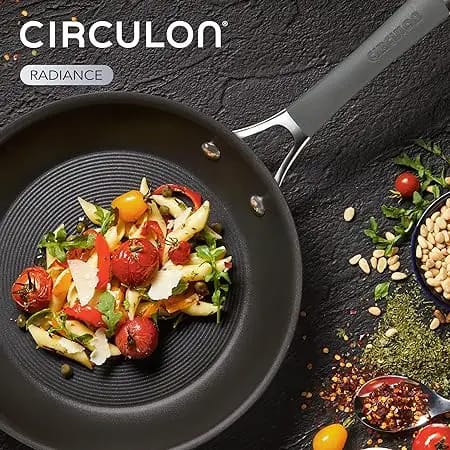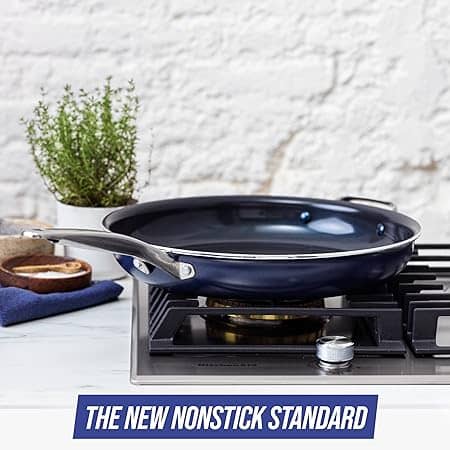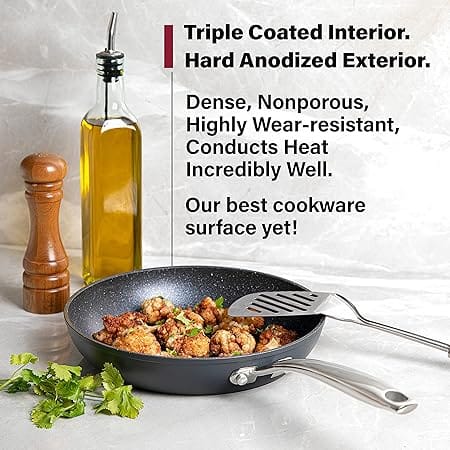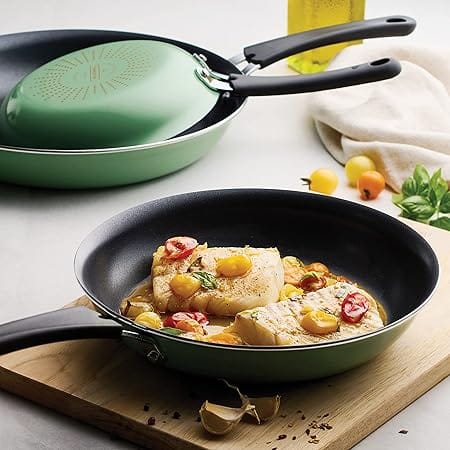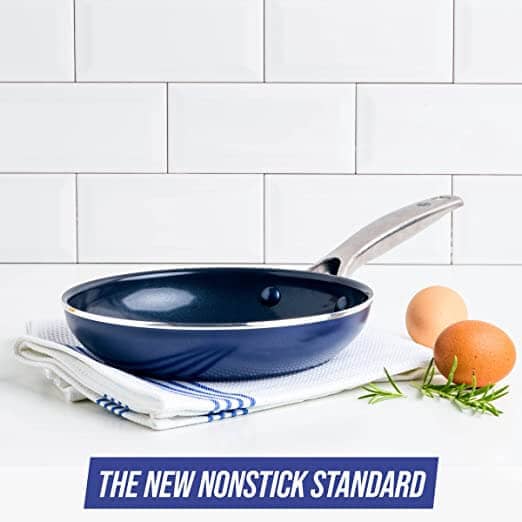Deep Frying Pan Mastery: Budget-Friendly Picks for Crispy Perfection (Safety First!)
Demystifying Deep Frying Pans: A Comprehensive Guide for Perfect Fried Feasts
For home cooks yearning to bring that crispy, golden-fried restaurant experience to their own kitchens, deep frying pans have become an essential tool. These versatile pans allow you to indulge in everything from perfectly fried chicken to fluffy tempura vegetables, all within the comfort of your home. But with an array of choices and factors to consider, choosing the right deep frying pan can feel overwhelming. This comprehensive guide dives deep (pun intended) into everything you need to know about deep frying pans, empowering you to make informed decisions and conquer the art of deep frying at home.
What is a Deep Frying Pan?
A deep frying pan is a specialized cookware item designed for cooking food submerged in hot oil. It typically features a tall, straight sidewall that allows for ample oil capacity and prevents splatter. Deep frying pans are usually crafted from sturdy materials like stainless steel or cast iron, ensuring even heat distribution and durability for withstanding high temperatures.
Here’s a breakdown of some key characteristics of deep frying pans:
- Tall Sidewalls: The defining feature, these tall sides prevent excessive splatter and oil burns while deep frying.
- Heavy Duty Construction: Deep frying pans are built to handle the high heat required for deep frying, often using materials like stainless steel or cast iron.
- Wide Base: A wide base provides stability and even heat distribution throughout the pan.
- Long Handle: Many deep frying pans feature a long handle for safe maneuvering and keeping your hands away from the hot oil.
- Lid (Optional): While not essential, some deep frying pans come with lids to help contain heat and splatter or keep food warm after frying.
Beyond these core features, deep frying pans can come in various sizes and materials to suit different preferences and cooking needs.
Benefits of Using a Deep Frying Pan
Deep frying pans unlock a world of culinary possibilities, offering numerous advantages for home cooks:
- Restaurant-Quality Fried Food: Achieve that crispy, golden-fried perfection you crave, from perfectly cooked french fries to juicy fried chicken.
- Versatility: Deep frying pans aren’t limited to just frying. They can be used for braising, stewing, boiling large quantities of food, or even making popcorn.
- Efficient Heat Distribution: The sturdy construction of deep frying pans, often featuring metals like stainless steel or cast iron, ensures even heat distribution for consistent cooking results.
- Large Capacity: The deep design allows you to cook larger batches of food at once, perfect for feeding a crowd or meal prepping.
Choosing the Right Deep Frying Pan for You: Size, Material, and More
When selecting a deep frying pan, consider these crucial factors to ensure it aligns perfectly with your cooking needs:
Size
Deep frying pans come in various sizes, typically ranging from 8 inches to 16 inches in diameter. Here’s a guide to choosing the ideal size based on your cooking habits:
- 8-10-inch Pans: Perfect for small batch frying or limited counter space.
- 12-14-inch Pans: Ideal for most household needs, allowing you to fry moderate quantities of food.
- 16+ Inch Pans: Well-suited for large families or frequent entertaining, catering to bigger batches of fried food.
Material
The material of your deep frying pan significantly impacts its performance and heat retention:
- Stainless Steel: A popular choice, offering durability, even heat distribution, and compatibility with most stovetops (including induction). However, stainless steel pans may require more oil to prevent sticking.
- Cast Iron: Renowned for exceptional heat retention and even cooking, cast iron deep frying pans are incredibly versatile. However, they can be heavy and require proper seasoning for optimal performance.
- Enameled Cast Iron: Combines the heat retention of cast iron with a nonstick enamel coating for easier cleanup. Be mindful that the enamel coating can chip over time with rough handling.
Additional Considerations
- Lid: While not essential, a lid can be helpful for containing splatter, retaining heat, or keeping food warm after frying.
- Basket Insert (Optional): Some deep frying pans come with a basket insert that allows you to easily lift food out of the oil for draining and prevents overcooking.
- Heat Source Compatibility: Ensure the pan you choose is compatible with your stovetop (gas, electric, or induction).
Choosing the Right Deep Frying Pan for You: Size, Material, and More (continued)
Factor | Description |
Size | Ranges from 8-inch to 16-inch, suitable for various batch sizes. |
Material | Stainless steel for durability and even heat, cast iron for excellent heat retention, or enameled cast iron for nonstick convenience. |
Additional Considerations | Lid for splatter control and heat retention, basket insert for easy food retrieval, and heat source compatibility. |
Using and Maintaining Your Deep Frying Pan: For Safe and Successful Frying
Now that you’ve chosen the perfect deep frying pan for your culinary adventures, proper use and maintenance are essential for safety, optimal performance, and a long lifespan for your pan.
Safe Frying Practices
- Oil Selection: Use oil with a high smoke point, such as canola oil, peanut oil, or vegetable oil. Avoid olive oil, which has a lower smoke point and can burn easily.
- Oil Temperature: Maintain the correct oil temperature for optimal results. Use a deep-fry thermometer to monitor the temperature, typically ranging from 350°F to 375°F for most frying applications.
- Safety Gear: Consider wearing oven mitts and safety glasses when handling hot oil to prevent burns and splatters.
- Don’t Overload the Pan: Avoid overcrowding the pan with food, as this can lower the oil temperature and lead to uneven cooking. Fry food in batches for best results.
Cleaning and Maintenance
- Cooling Down: Always allow the oil and pan to cool completely before cleaning. Never attempt to quench hot oil with water, as this can cause dangerous splatters.
- Oil Disposal: Discard used oil responsibly. Let the oil cool and solidify, then transfer it to a sealed container for disposal at a designated recycling center. Never pour used oil down the drain.
- Cleaning the Pan: Once cool, wash the pan with warm soapy water and a gentle sponge. For stubborn residue, you can soak the pan or use a baking soda paste. Avoid abrasive scrubbers that can damage the pan’s surface.
- Drying: Dry your deep frying pan thoroughly before storing it to prevent rust, especially for cast iron pans.
Deep Frying Tips and Techniques
- Pat Dry Food: Ensure food is completely dry before frying to prevent excessive splattering and ensure crispy results.
- Seasoning (Optional): Cast iron pans benefit from seasoning to create a nonstick surface. Follow proper seasoning instructions for your specific pan.
- Gradual Immersion: Slowly lower food into the hot oil to prevent splatter and oil burns.
- Monitor Food Closely: Don’t overcrowd the pan and keep an eye on the food to prevent burning.
By following these safety practices, cleaning techniques, and helpful tips, you can ensure safe and successful deep-frying experiences with your deep frying pan for years to come.
Beyond Deep Frying: Exploring the Versatility of Deep Frying Pans
Deep frying pans aren’t just for, well, deep frying! Their versatility extends to various cooking techniques, making them valuable additions to any kitchen:
- Sautéing and Searing: The wide base and high heat capacity of deep frying pans make them perfect for sautéing vegetables, searing meats, or browning ingredients.
- Stewing and Braising: The deep design allows for simmering large quantities of liquids, ideal for stews, braises, or slow-cooked meals.
- Boiling: Heat a large pot of water for pasta, potatoes, or dumplings with ease in your deep frying pan.
- Stock Making: The sturdy construction makes deep frying pans suitable for simmering bones and vegetables to create flavorful homemade stock.
With a little creativity, your deep frying pan can become a multi-purpose workhorse in the kitchen, tackling a variety of cooking tasks beyond just achieving that restaurant-style deep-fried perfection.
Deep Frying Pan Alternatives: Exploring Different Options
Deep frying pans offer undeniable advantages for achieving crispy fried goodness. However, depending on your cooking needs and preferences, there might be suitable alternatives to consider:
Dutch Oven: A Dutch oven is a heavyweight pot with a tight-fitting lid, renowned for its exceptional heat retention and versatility. While not ideal for large batches of deep frying, a Dutch oven can handle smaller portions and excels at braising, stewing, and slow cooking.
Heavy-Bottomed Stock Pot: Similar to a Dutch oven, a heavy-bottomed stock pot features a large capacity and even heat distribution. It’s perfect for boiling large quantities of food, making soups and stocks, or simmering stews. While not designed for deep frying, it can handle shallow frying tasks.
Electric Deep Fryer: For frequent deep-frying endeavors, an electric deep fryer offers a dedicated appliance with features like temperature control, filtration systems, and safety mechanisms. Electric deep fryers can be a convenient option for achieving consistent results and minimizing
- Large Skillet: A large skillet, particularly one made from cast iron, can be used for shallow frying tasks like pan-frying fish or chicken cutlets. While not ideal for deep frying due to its lower sidewalls, a large skillet offers versatility for various cooking techniques.
Here’s a table summarizing the key differences between deep frying pans and some popular alternatives:
Feature | Deep Frying Pan | Dutch Oven | Stock Pot | Electric Deep Fryer | Large Skillet |
Primary Use | Deep Frying | Braising, Stewing, Slow-Cooking | Boiling, Simmering | Deep Frying | Pan-Frying |
Suitability for Deep Frying | Excellent | Limited (small batches) | Limited (shallow frying) | Excellent | Limited (shallow frying) |
Versatility | Moderate | High | High | Limited | Moderate |
Heat Retention | Good | Excellent | Excellent | N/A | Good |
Temperature Control | Requires separate thermometer | May require heat adjustments | Requires separate thermometer | Electronic controls | Requires heat adjustments |
Ultimately, the best choice depends on your individual needs. If deep frying is a frequent activity, a dedicated deep frying pan might be ideal. But for occasional deep frying and a broader range of cooking applications, a Dutch oven, stock pot, or large skillet might be more versatile options.
Deep Frying Safety Precautions: A Top Priority
Deep frying can be a fun and rewarding way to cook, but it’s crucial to prioritize safety throughout the process. Here are some essential precautions to remember:
- Oil Selection and Smoke Point: Choose an oil with a high smoke point, which is the temperature at which the oil starts to break down and smoke. Can canola oil, peanut oil, or vegetable oil handle the high temperatures required for deep frying? Avoid olive oil, as it has a lower smoke point and can burn easily.
- The thermometer is Your Friend: Invest in a deep-fry thermometer to monitor the oil temperature precisely. The ideal temperature typically ranges from 350°F to 375°F for most frying applications. Overheating oil can lead to burns and fire hazards.
- Water and Hot Oil Don’t Mix: Never attempt to quench hot oil with water. This can cause a violent eruption and serious burns. If a fire ignites, turn off the heat source immediately and smother the flames with a metal lid or baking soda. Do not use water.
- Keep a Fire Extinguisher Handy: Having a fire extinguisher readily available in your kitchen is essential for any cooking task involving high heat, including deep frying. In case of a fire, know how to use the extinguisher properly.
- Beware of Spattering: Hot oil can splatter and cause burns. Wear oven mitts and safety glasses to protect yourself from splatters while adding food or maneuvering the pan.
- Don’t Overload the Pan: Overcrowding the pan with food can lower the oil temperature and lead to uneven cooking, potentially causing excess splatter and creating opportunities for burns. Fry the food in manageable batches for optimal results.
- Keep Children and Pets Away: Deep frying involves hot oil and splatters, posing a risk to curious children and pets. Keep them away from the cooking area to ensure their safety.
By following these safety precautions, you can minimize risks and ensure a safe and enjoyable deep-frying experience. Remember, safety always comes first in the kitchen.
Here are some reputable brands known for producing high-quality deep frying pans
- All-Clad: Renowned for its top-tier stainless steel cookware, All-Clad offers deep frying pans known for exceptional heat distribution and durability.

- Lodge: A champion of cast iron cookware, Lodge offers deep frying pans at a more affordable price point. Their cast iron pans deliver excellent heat retention and versatility but require proper seasoning for optimal performance.
Calphalon: Offering a variety of nonstick cookware options, Calphalon might be a good choice if you prioritize a non-stick surface for easier cleanup. Explore their selection of deep frying pans to find one that suits your needs.
- Circulon: This brand focuses on hard-anodized aluminum cookware with a proprietary nonstick coating. Circulon deep frying pans might be a good option if you seek a balance between durability, nonstick performance, and ease of maintenance.
- Cuisinart: A well-known brand offering various kitchenware options, Cuisinart also produces deep frying pans. Their selection might cater to budget-conscious buyers looking for a functional deep frying pan.
Here are some additional tips for choosing a deep frying pan brand:
- Read Reviews: Look for online reviews from verified purchasers to gain insights into real-life experiences with different brands. Reviews can highlight factors like performance, durability, and ease of use.
- Consider Brand Reputation: Research the brand’s overall reputation and warranty policies. Positive reviews and a strong warranty indicate a manufacturer is confident in the quality and longevity of their products.
- Material and Features: Choose a brand that aligns with your desired material (stainless steel, cast iron, etc.) and preferred features (lid, basket insert, etc.).
By considering these factors and exploring brands known for their deep frying pans, you’ll be well-equipped to choose the perfect pan to elevate your deep-frying endeavors in the kitchen.

Deep Frying Fun Facts and Recipe Inspiration
Now that you’ve explored the world of deep frying pans, safety measures, and alternative options, let’s add a dash of fun and flavor!
Deep Frying Fun Facts:
- Deep frying is an ancient cooking technique, with evidence suggesting its use in Mesopotamia as early as 2500 BC.
- Scotland’s iconic deep-fried Mars bar is a testament to the global love affair with deep-fried treats. (Though perhaps not the healthiest!)
- Tempura, a Japanese culinary staple featuring lightly battered and deep-fried vegetables and seafood, originated in the 16th century.
- The invention of the pressure cooker in the early 20th century led to the development of the first electric deep fryer in the 1930s.
Recipe Inspiration to Ignite Your Deep Frying Journey
Ready to put your newfound deep frying knowledge to the test? Here are some recipe ideas to get you started:
- Classic Southern Fried Chicken: Perfectly seasoned and crispy on the outside, juicy and tender on the inside. A true comfort food classic.
- Crispy French Fries: The ultimate side dish or movie night snack. Master the art of golden-brown, fluffy fries at home.
- Tempura Vegetables: Light and flavorful, showcasing the beauty of fresh seasonal vegetables.
- Onion Rings: A crowd-pleasing appetizer featuring crispy battered onion slices.
- Mozzarella Sticks: Gooey melted cheese encased in a golden-fried crust. A guaranteed crowd-pleaser!
Remember, these are just a springboard for your deep-frying adventures. With a deep frying pan and a little creativity, you can explore a world of delicious possibilities, from savory snacks to sweet treats.
Final Thoughts
Deep frying pans unlock a world of culinary possibilities, allowing you to recreate restaurant-quality fried favorites at home. By choosing the right pan, prioritizing safety, and exploring different techniques, you can master the art of deep frying and create delicious meals that will tantalize your taste buds. So, fire up your stove, grab your deep frying pan, and get ready to experience the joy of crispy, golden-fried goodness!

